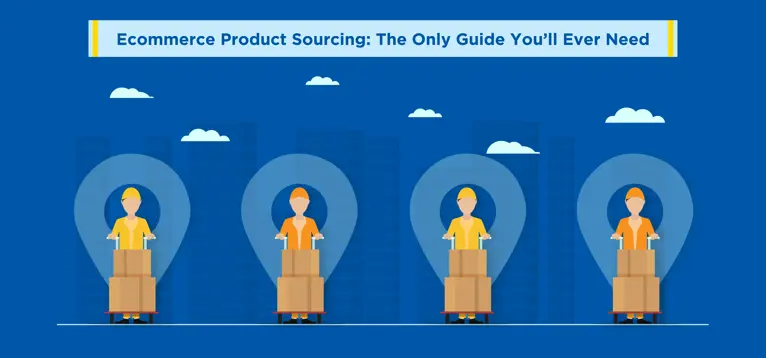As we can recall from the Pirates of the Caribbean, Captain Jack had to sail through the vast ocean to the Island called Tortuga to source necessary items and the crew.
Just as crucial the crew is for the ship to sail in the sea, products also have the same vitality to start and sustain your eCommerce journey. However, you won’t have to travel to Tortuga or the world’s end to source the required products.
Today, merchants can source products comfortably from home without travelling a mile thanks to global connectivity. They have the flexibility to import products from different regions of the world.
But what does sourcing mean? In this guide, we’ll explore various aspects of product sourcing to help you get started on your sourcing journey.
What is Product Sourcing?
Product sourcing is a process of finding wholesalers, manufacturers, and distributors for buying products locally or importing from other countries in bulk at affordable prices. The goal here is to locate reliable suppliers for businesses to source products to sell on their online store with enough profit margin.
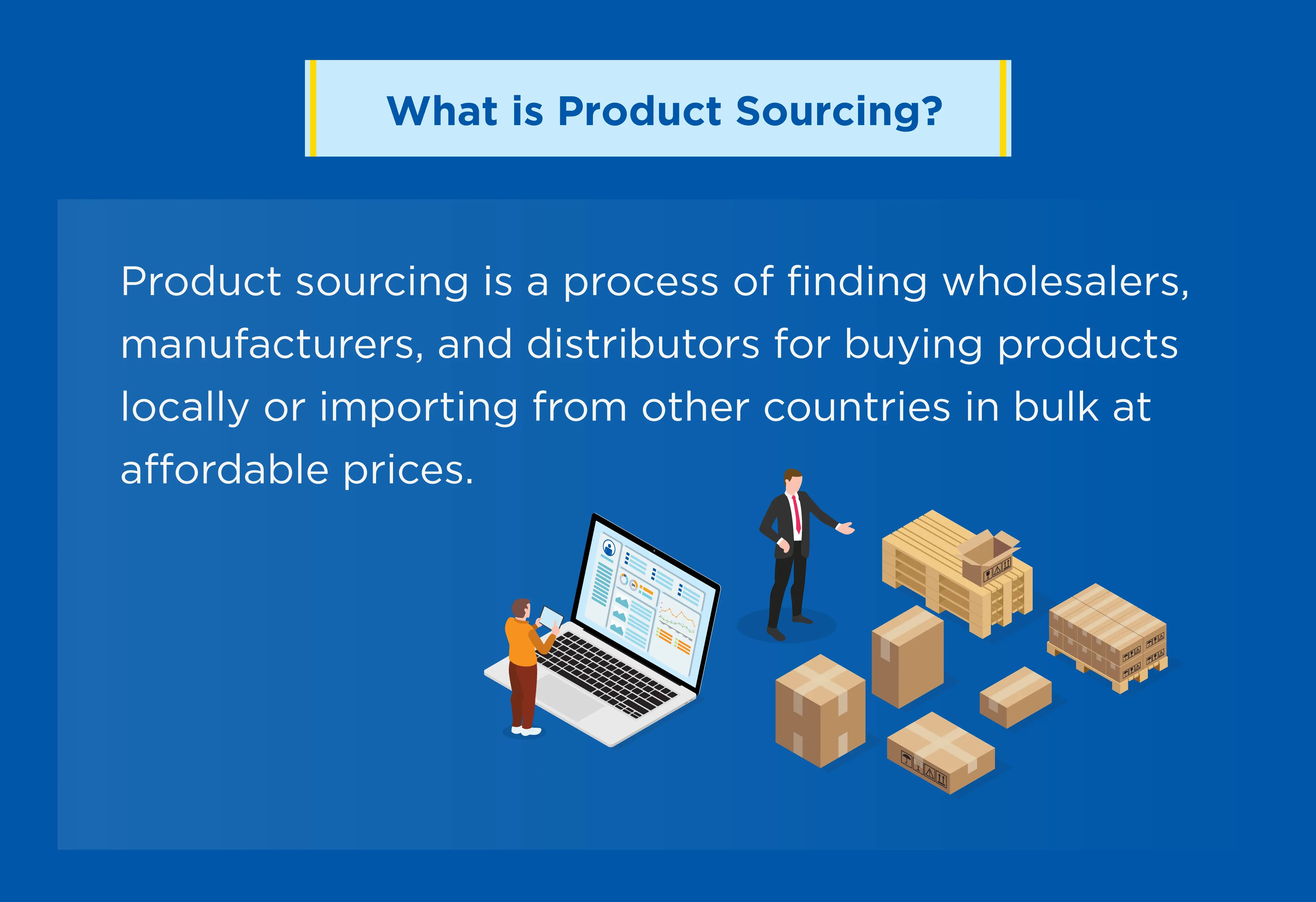
However, it’s not as simple as it seems because the industry is filled with many unreliable suppliers, low-quality products, and hidden costs, which make it difficult for beginners.
Thus, you first need to understand how product sourcing works and learn the tips & tricks that give you an edge over others.
If not all, then you must learn to source products from China as the country has the largest manufacturing hub on the planet. You can even hire a sourcing agent that helps make the process easier and much more efficient.
However, one challenge many eCommerce owners face is they get confused about what products to source. They have no clue about the best products that help their eCommerce business to flourish. So, let’s first clear that up:
Different Products Sourcing Types
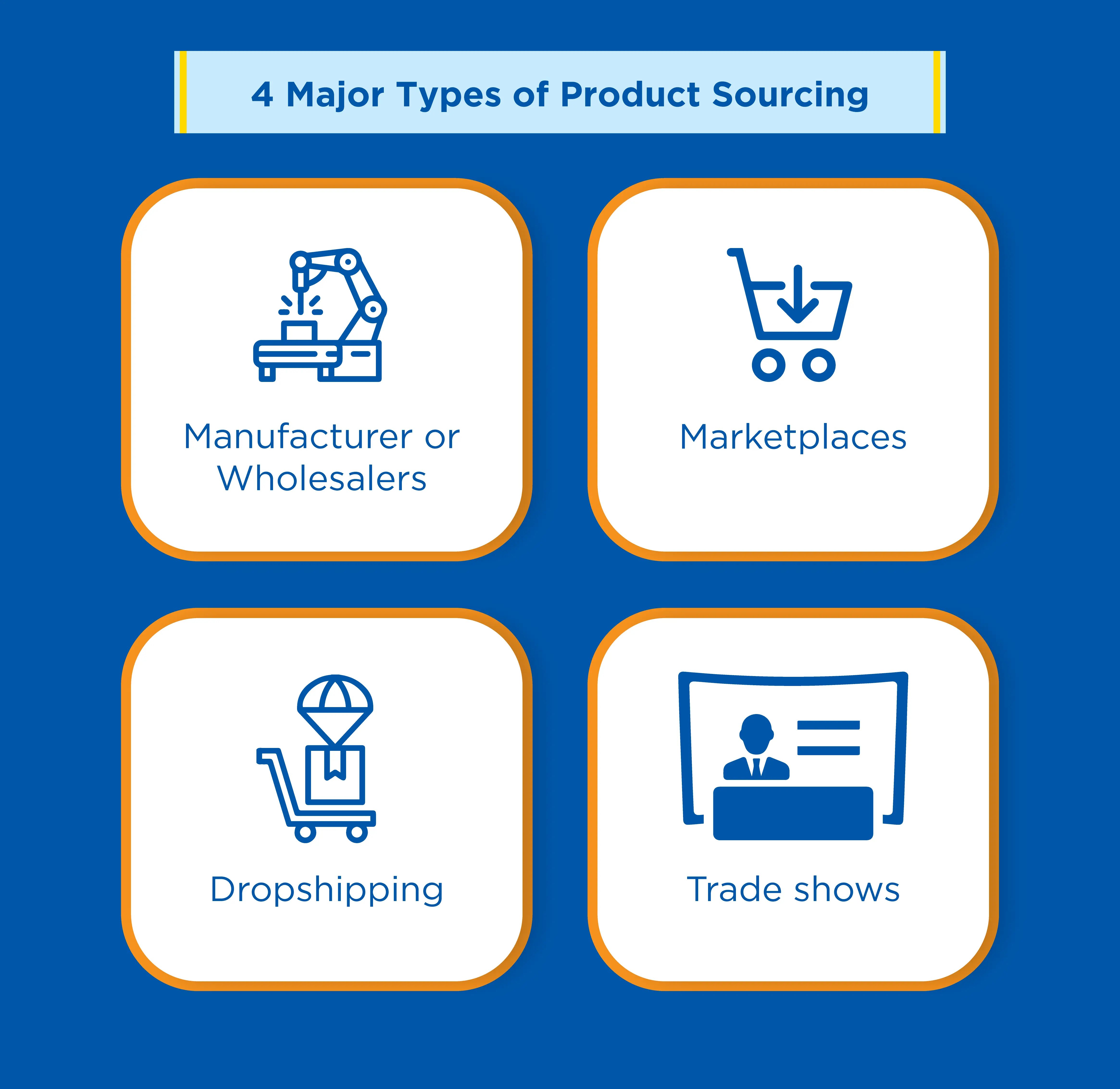
Sourcing from Manufacturers or Wholesalers
If your eCommerce business sells custom goods with technical specifications, it’s best to source them directly from manufacturers. For the same, you need to put in some effort to unearth suitable wholesalers and manufacturers with sufficient production capacity and technical adaptability.
Sourcing products directly from manufacturers or wholesalers has its own perks. For instance, you don’t have to handle the manufacturing unit, keep the raw materials in check, or worry about labour wages.
Apart from that, you get instant access to a wide variety of goods and purchase them in bulk at lower prices. Moreover, your users can get a taste of new brands and a supply of unique products at once.
Pros of Sourcing from Manufacturers & Wholesalers
- Easy inventory scaling to include more brand products
- Ability to source custom goods and niche products
- Risk aversion and business diversification
Cons of Sourcing from Manufacturers & Wholesalers
- Sourcing costs can turn up high due to increased demand & limited supply
- A lot of negotiation & paperwork is involved
- Need to meet the Minimum Order Quantity (MOQ) requirements
Checklist to Get Started
- Start by finding local manufacturers and suppliers with technical expertise
- Look up for manufacturers or wholesalers on Alibaba, eBay, and others to partner with them
- Properly vet and audit your partners for legitimacy
- Evaluate the production and goods supply capacity of finalised manufacturers and wholesalers
- Order some samples and check thoroughly to ensure they meet your requirements
- Weigh in your options and decide by considering the price, quality, and market demand
Marketplaces for Product Sourcing
Finding it tough to discover suppliers that offer specific kinds of products? Global marketplaces are great to begin your hunt for quality suppliers for business.
There are several all-purpose marketplaces like eBay, Etsy, Amazon, and others. Also, you can utilise China-specific marketplaces like Alibaba, Made-in-China.com, AliExpress, and others.
These marketplaces cover pretty much everything from household items to industrial goods that global eCommerce merchants can source. Moreover, there are several niche-specific marketplaces like:
- Houzz for home decor items
- StockX for clothing, collectibles and electronics
- GAME for game collectibles, toys, and computer games
- AbeBooks for new and used books
- Reverb for sourcing music instruments
- Austrade for finding local Australian suppliers and manufacturers
Pros of Using Marketplaces for Sourcing
- No or low MOQ requirement to meet
- Can source a diverse range of goods quickly
- Not much legal work is involved
Cons of Using Marketplace for Sourcing
- Higher rates than wholesalers or manufacturers
- Limited availability of required goods
- Can take longer to arrive for international consignments
Checklist to Get Started
- Determine the items to source and contact the seller
- Inquire about stocks of available items to source in large quantity
- Build long-term relationships for regular product imports
- Read reviews to evaluate the reseller and product quality
- Try local market places to discover small entrepreneurs and manufacturers
Sourcing from Dropshipping Suppliers
eCommerce businesses based on the dropshipping model can leverage dropshipping suppliers to meet their product sourcing needs. While you can browse the marketplaces mentioned above individually to find reliable suppliers, or you can trust dropship suppliers for the same.
However, you don’t want to rush into selecting dropshipping suppliers but conduct thorough research to choose the best ones. AliDropship, CJDropshipping, Ozdingo, and others are some well-known dropshipping suppliers.
Pros of Sourcing from Dropshipping Suppliers
- Variety of products to source for your dropshipping business
- Unified marketplace to research and find suitable products from several sources
- Ease of handling bulk orders
Cons of Sourcing from Dropshipping Suppliers
- Difficult for inexperienced or beginner dropshippers
- Shipping & fulfilment can be slow and tedious at times
Checklist to Get Started
- Conduct an ample amount of research to compile a list of noteworthy suppliers
- Order some samples first for a trial run and inspect the quality
- Check out the suppliers used by your competitors to find some useful sources
- Find several alternatives to source similar products from
- Plan for integrating eCommerce shipping solutions to deliver domestic and international orders
Participating in Trade Shows
Trade shows are effective in connecting suppliers with buyers and brand owners. It’s where your quest for unique and innovative private label products end.
Participating in trade shows is even necessary as it helps you discover manufacturers and distributors that don’t have an online presence and are new in the market. Thus, your chances of finding a unique product increase further when participating in various trade shows around the globe.
Pros of Sourcing from Trade Shows
- Gain access to a vast number of suppliers offline
- See and inspect products on the spot
- High chances of finding novel products
Cons of Sourcing from Trade Shows
- High cost of participation and commute if attending international trade shows
- Overwhelming for beginners
- Suppliers tend to work with big brands with high MOQ
Checklist to Get Started
- Decide on your agenda to attend a trade show
- Prepare a list of items you want to buy and decide per item rate
- What is the MOQ you are fine with?
- Evaluate if the product is unique, easy to ship, and has sufficient demand in the market
- Have an open conversation with your trade show suppliers
6 Essential Steps for Successful Product Sourcing
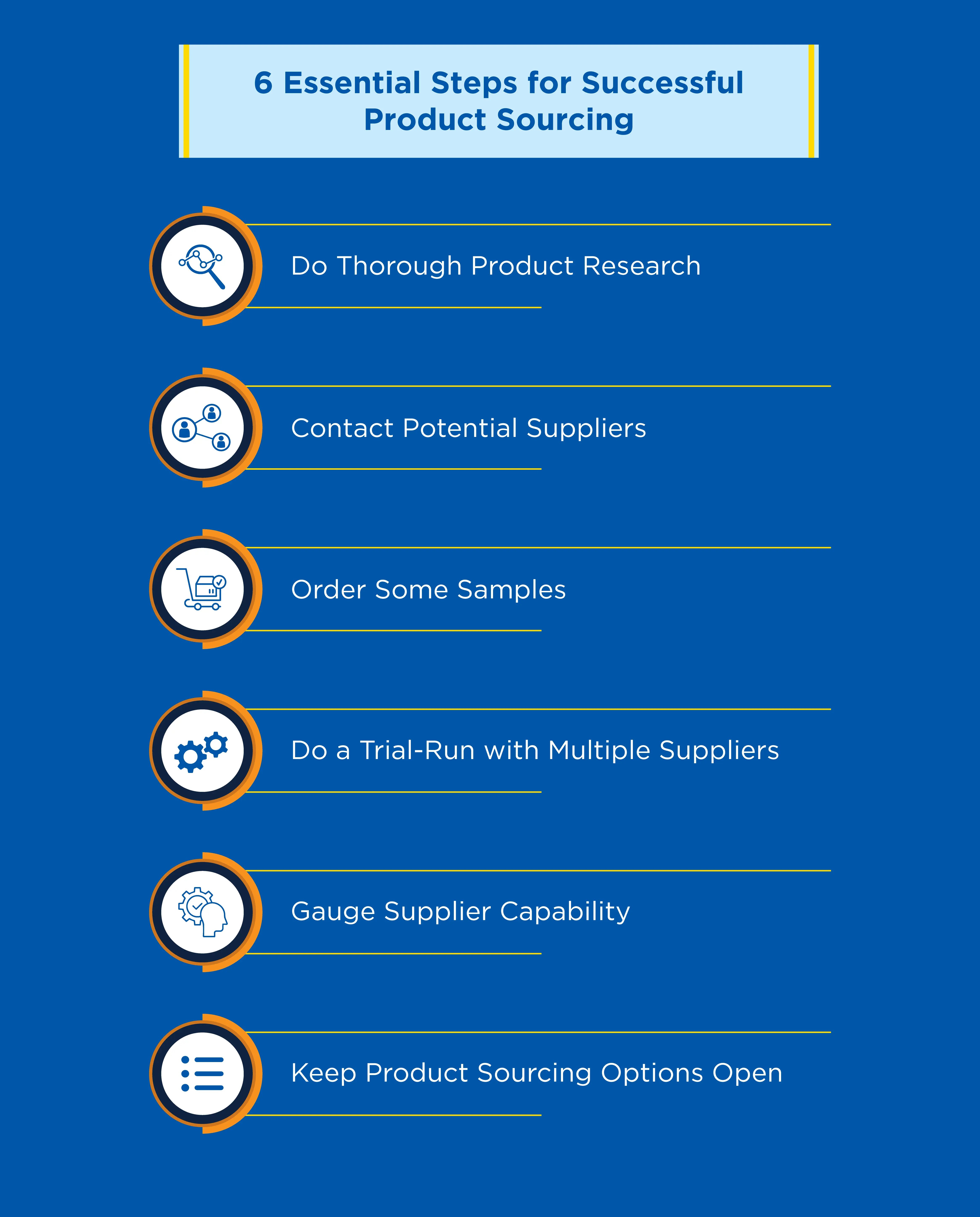
Product sourcing is not going to be a cakewalk as finding top-quality goods takes time and the process can seem a bit overwhelming for beginners. Here are some steps you need to follow before you embark on the product sourcing journey:
1. Do Thorough Product Research
Product sourcing not backed by solid research is like giving an invitation to failure. Retailers need to do well-rounded research that uncovers insights about how a product performs in the market, sales figures, consumer demand, and trends.
Before you visit any marketplace, attend any trade show, or decide to source from manufacturers or wholesalers, understand the product inside out. Researching the product market and how consumers drive up the demand is a necessary step to success.
Let’s understand what you need to research:
- Data Crunch: Gather around the sales growth data that justify sourcing products in large quantities for your eCommerce.
- Consumer Demand: Sourcing products with no demand in the market makes no sense. Find products your consumers are seeking and even use the above data to make connections with consumer demands to determine what products to source.
- Market Trends: Trends tell you a lot about what products are ruling the market. Your job is to find and address such trends while sourcing.
Product sourcing backed by strong research gives you the sense to make informed decisions. The more you know the better it is for you to connect with suppliers and get in-demand products that live for a short period on your shelves.
2. Contact Potential Suppliers
Now that you are equipped with the knowledge and better understanding of the market, it’s time to contact potential suppliers for business processes. But before you make any attempt, have some perspective on what you want out of them.
Since you have researched the product specifications well enough, you need to communicate the same with your suppliers. You need to make them understand your product requirements before you sign any contract.
Being upfront with your suppliers will help smoothen out the process. Also, this is the step where you connect with suppliers you met at trade shows and get to know their requirements better.
3. Order Some Samples
After you have finalised and contacted your suppliers, it’s time to order some samples and inspect the quality of the product. Ordering samples is like taking a test drive before we purchase a new car.
Sourcing products is a long-term game and your e-store’s success depends on it. So ask for samples to inspect the product quality beforehand. Also, it's a necessary step as you can ask for feedback about the product from your team members.
It allows you to feel the product up-close and scrutinise what’s good and what’s not and can go with the general consensus to order further lots.
4. Do a Trial-Run with Multiple Suppliers
Many times, a sourcing deal with an ideal candidate can go sideways, which is where the need for backup suppliers originates. For such scenarios, you need to prepare a list of best-fit manufacturers or suppliers to reach out to for a trial run.
You can ask them for sample units to test on your eCommerce website to see users’ response and how it performs. You can even order multiple items for trial to examine what consumers buy the most and what products sell faster than others.
Set some KPIs and indicators to note down the sales growth, performance, and consumer feedback of each product. Doing so allows you to make informed decisions to source the right products from the right manufacturers or suppliers.
5. Gauge Supplier Capability
Once you have narrowed down to the right fit suppliers for sourcing products, you want to evaluate if your supplier has sufficient capacity to fulfil your orders. Or vice Versa, does your eCommerce business have sufficient need to meet the supplier’s MOQ requirements?
After the completion of the trial run, analyse how successful it was and did it live up to your expectations. Depending on how it performed, you would reach a minimum order quantity a supplier has to fulfil that can last you for a month or a quarter.
Once you have this tentative figure, communicate it with your supplier clearly for sending timely product shipments. Further, discuss what would happen if the items get damaged during the transportation and who would bear the cost.
Such intricate details can make or break your relationship with your supplier. Be honest and provide constructive feedback when communicating why the relationship isn’t moving forward.
6. Keep Product Sourcing Options Open
Due to unforeseen circumstances like suppliers going out of the market or merging with others, it can become hard to get the necessary supply of items. Such unexpected events can happen at any time, and the only way to deal with it is to be prepared for them.
You need to keep your product sourcing options open as not seeing their favourite item in the store can impact your consumer loyalty. Consumers turning away from your eCommerce store can be a huge blow to your sales and business growth.
The only way to avert this nightmare is to keep other suppliers handy whenever things start to go sideways. This not only ensures that the product supply will not get disrupted but also keeps your customers happy when seeing their favourite items in stock always.
8 Best Places to Find Trending Products to Source
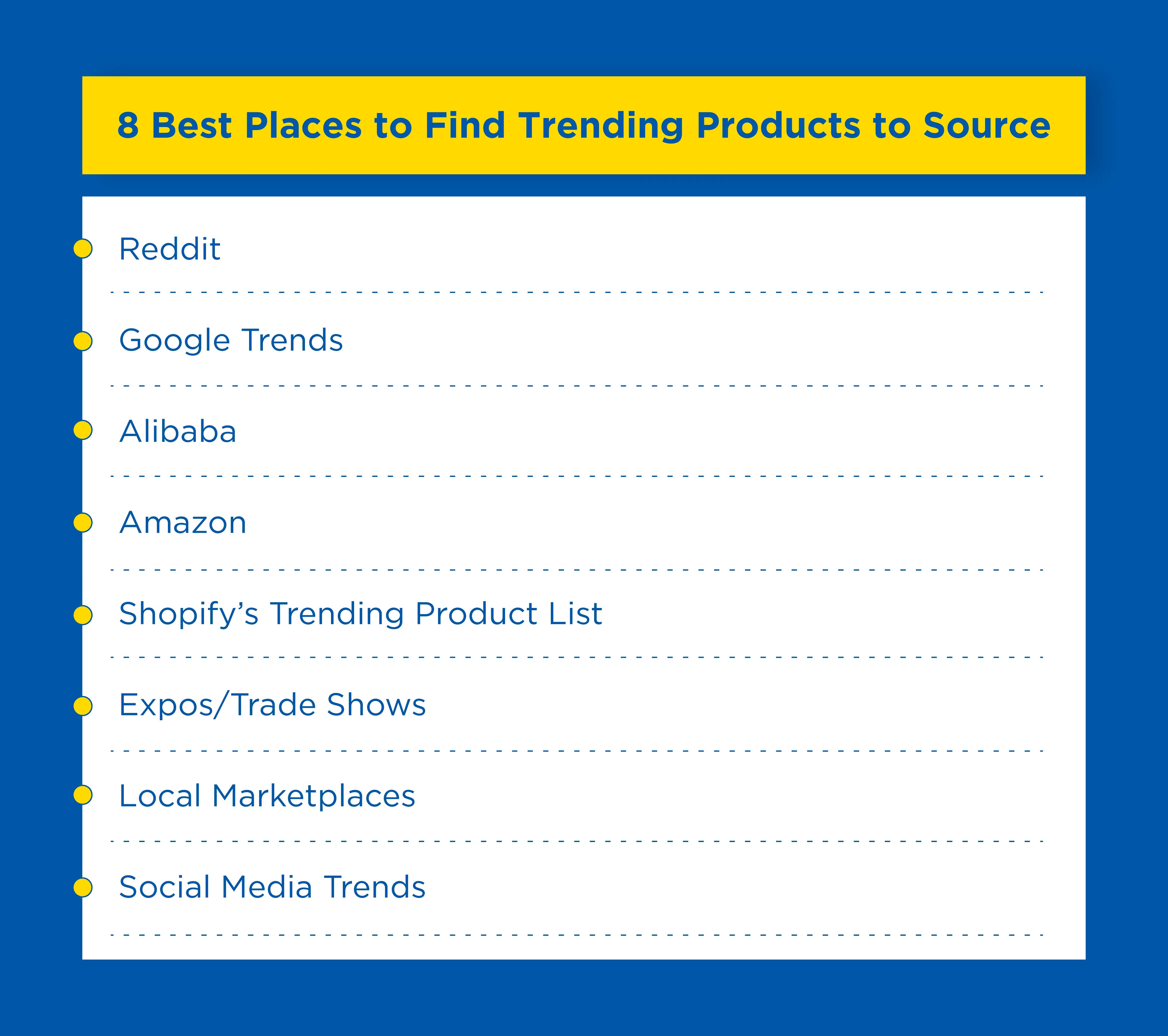
While the above-mentioned steps will help you find the ideal manufacturers or suppliers, how do you know what are the best products to sell?
In order to be successful, eCommerce companies need to thoroughly vet the market to find the trending products that get them the initial traction. Here are the 8 best places to discover trending products:
1. Reddit

Reddit has some legitimate discussions on a range of different topics including what products users are interested to buy. The only catch is you have to dig deep into finding the right subreddits and explore the conversations users have.
For instance, “Shut Up and Take My Money” is a product-focused subreddit to uncover interesting products. However, you must explore subreddits relevant to your niche to squeeze as much insights as possible out of them.
2. Google Trends
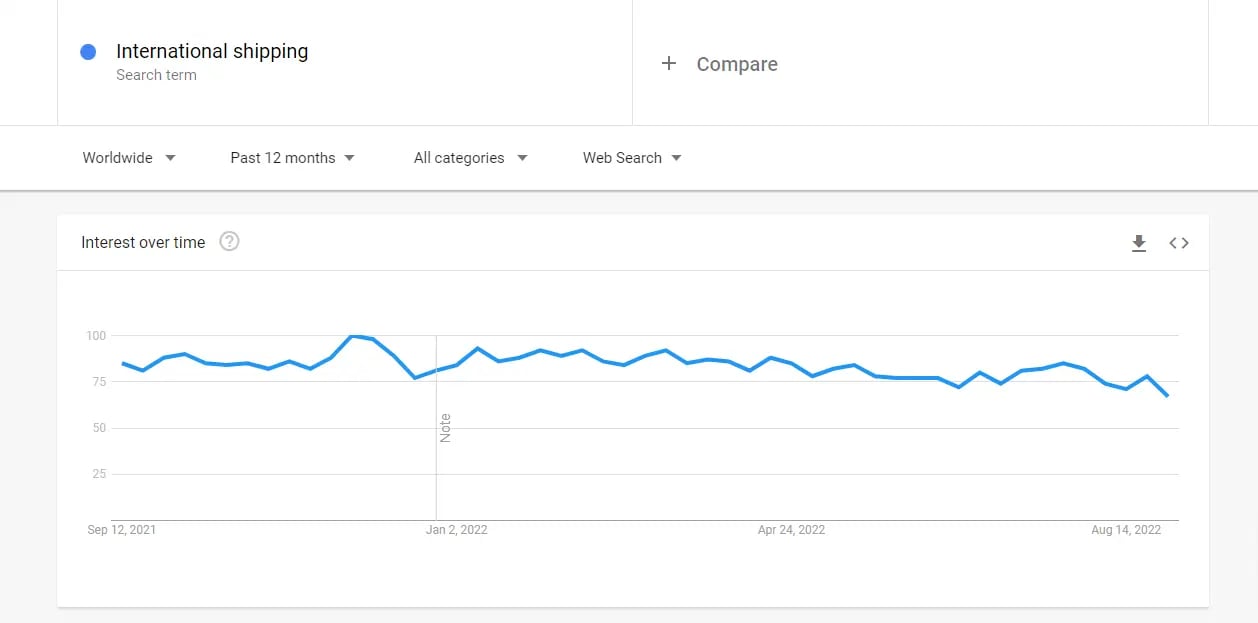
Leveraging Google Trends is an innovative way to search for new products with high search volume over a specific period. Not only that, but you can also discover popular items trending currently and capitalise on them as well.
However, the drawback of using it is if something is trending right now, it doesn’t mean it’ll be in trend after 6 or 12 months. Still, you can use Google trends effectively to discover plots of trends or patterns to gain momentary benefits by sourcing products accordingly.
3. Alibaba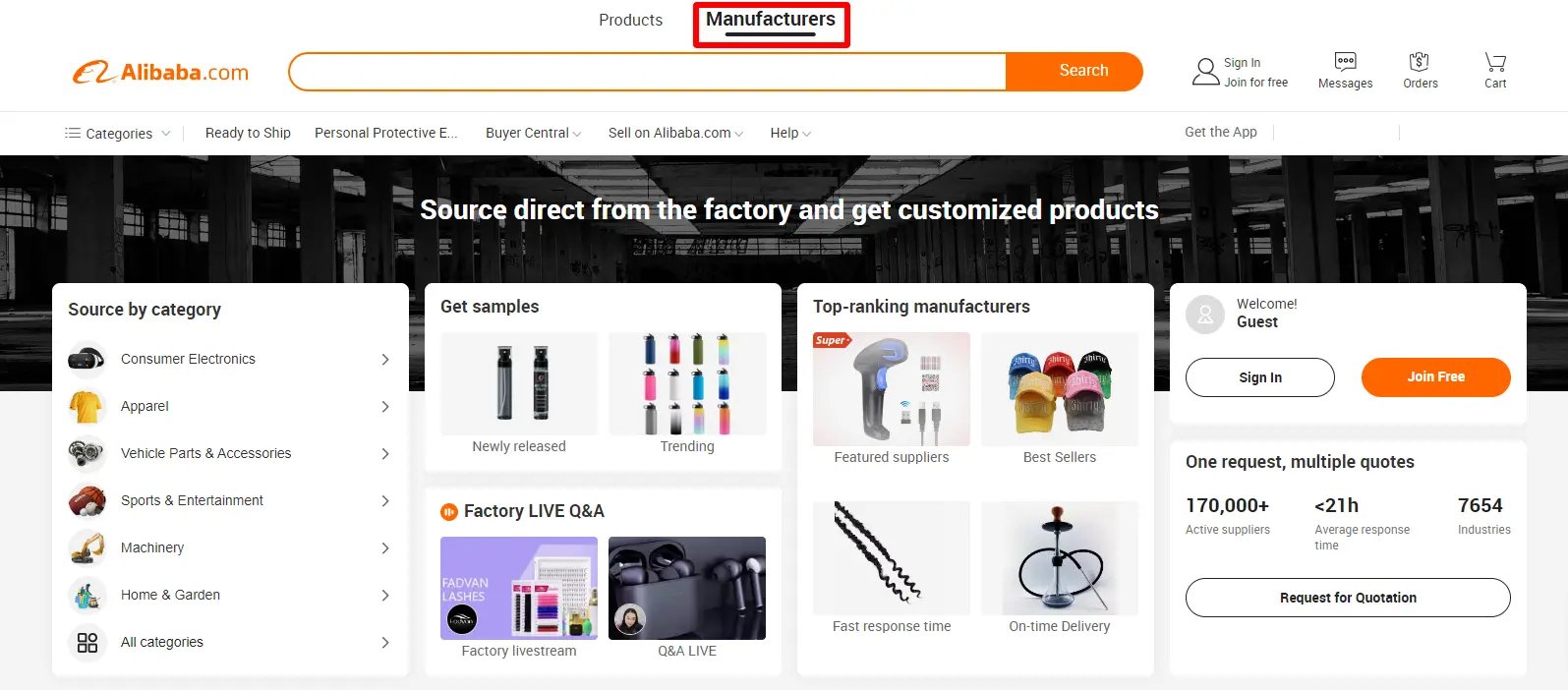
Alibaba is a Chinese Business-to-Business marketplace where buyers meet manufacturers, wholesalers, and distributors. It works as a directory for businesses to find millions of products with information like quality certificates, third-party verifications, year of manufacturing, etc.
Alibaba is great if you want to source white label and private label products in large quantities directly from manufacturers. However, you must carry out adequate research on the suppliers and the products they sell.
Also, ask for samples, evaluate the quality, check MOQ requirements, and inspect other aspects before placing any order.
4. Amazon

Amazon primarily offers two different ways for buyers to find trending products to source: Amazon Suggest and Movers & Shakers List. Amazon Suggest provides you with an array of popular search terms within the search bar that are relevant to your niche and consumers have looked up for them.
Movers & Shakers List is another way to identify the popular and trending products in recent days. However, it’s a time-sensitive feature as the products on the list can keep changing with trends. Still, it’s a good place to start for dropshippers who want to source products from Amazon.
5. Shopify’s Trending Product List
Shopify is not an online store but a platform that helps eCommerce and dropshipping enthusiasts to build their brands. The platform does everything in its power to aid businesses improve their sales and revenue.
One of their endeavours is to provide a list of trending products eCommerce owners can source and sell on their Shopify store. The biggest benefit of this list is it’s based on real-life sales data and not on search volume.
Since the list shows what products consumers are purchasing, it’d be much better for you to source trending products.
6. Expos/Trade Shows
Another place to discover new and trending products is participating in expos and trade shows. As mentioned earlier, product expos and trade shows are designed to connect buyers with product manufacturers and suppliers.
It’s also an opportunity to mingle with some of the innovative product manufacturers that do not have an online presence. So, make a list of your niche-relevant expos and trade shows to discover some unique products your audience is interested in buying.
7. Local Marketplaces
Amid the boom of online sellers, local marketplaces and manufacturers are often neglected by eCommerce store owners. However, they are the best places one can leverage for sourcing products and save some bucks on shipping and customs.
However, finding quality manufacturers and suppliers locally may take some time but once set up, it’s one of the cost-effective and easiest methods of product sourcing.
8. Social Media Trends
Social media platforms are like a hive of trending topics, products, and information. Some of the trends do hold the power to make you an immense amount of money. Apart from Reddit, here are some social networks you can use for finding trending products:

You can use Twitter’s search bar to look for trending hashtags and niche-related phrases your audience engages with the most. Note down these topics and utilise them to make informed decisions for sourcing trending products that people are interested to shop online.
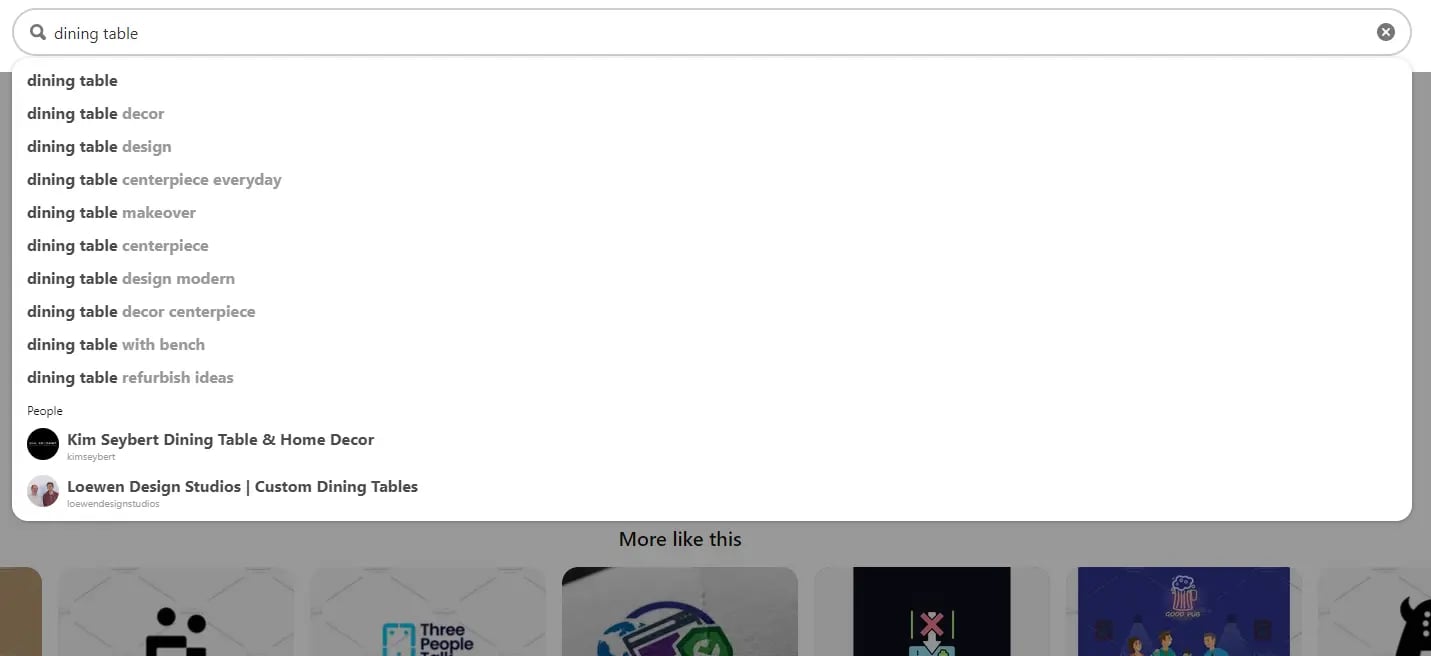
Apart from posting inspirational quotes and photos, Pinterest is also used for finding product recommendations. The photo posting network has a Suggest feature similar to Amazon where you can type your term in the search bar and get various suggestions.
These suggestions are usually the trending topics or searches users have made, which can give you ideas of what products are best for sourcing.
Facebook Ad Library

Often overlooked, the Facebook ad library is like a goldmine to find trending products for your online shop. Many new brands launch their product line only on Facebook to run targeted ad campaigns and lure as many customers in as possible.
So, it makes good sense to check out the ad Library for what your competitors are posting and launching. Doing so will give you multiple ideas to try and source the latest trending products.
YouTube
YouTube also enjoys an amazing audience who tend to be the trendsetter for products. Buyers can gauge the level of trending products by analysing the number of views, likes, and shares product videos get.

Unboxing and first impression videos particularly tend to do well on the platform and are beneficial to discover some great product ideas.
4 Ways to Validate the Product Sourcing Idea
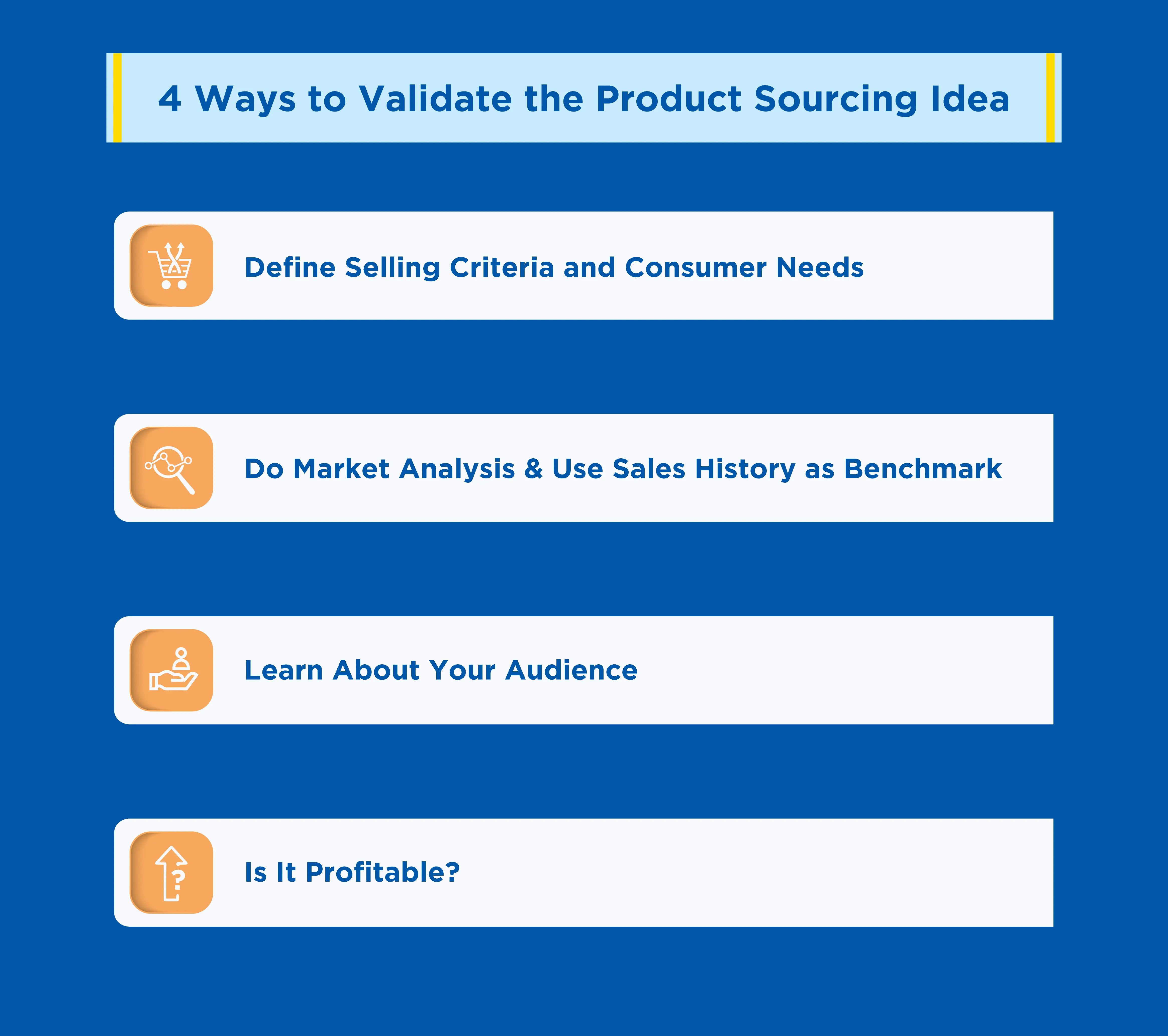
According to research by CBInsights, 35% of startups fail because the product they launched had no market need and 8% fail because of the poor product. So, how can you ensure that your product doesn’t meet the same fate as others?
In order to make sure you don’t invest in the wrong items, you’ll need to delve deep into validating your product sourcing ideas. Here are 4 ways to validate your ideas:
1. Define Selling Criteria and Consumer Needs
The first thing you want to do is define selling criteria and figure out if there’s enough demand in the market. Also, you want to analyse the market and see if it’s not saturated by competitor products and has sufficient room for your products to enter the market.
Here are some useful questions to ask:
- Does the market have a need for another product?
- Who are the biggest competitors?
- How can you stand out in a saturated market?
2. Do Market Analysis & Use Sales History as Benchmark
Market analysis involves getting to know your industry, niche, and audience. It helps you better understand the target market, competitive landscape, and product fit. Moreover, you can analyse how the product performs in the market and the volume of sales it can bring.
Here are a few things you want to identify:
- Target market size
- Sales history in the last few years & future projections
- How much customers are willing to pay for the product?
- What are the strengths and weaknesses of your competitors?
3. Learn About Your Audience
Consumer needs and sales history give you a better opportunity to learn more about your target audience. They come in handy in this step to help you validate your product’s need in the market and find the best consumer segments that have a high probability to purchase or be an early bird.
Here’s how to learn more about your target audience:
- Survey your existing customers what they think about the new product
- Look through the market analytics tools to discover vital insights
- Host focus groups consisting of 8 to 10 people to get their honest opinions
4. Is It Profitable?
Even if everything checks out and indicates that the product is a good fit, the last thing you want to tick is if it's going to be a profitable deal for you or not.
You need some ballpark estimates of expenses involved in product sourcing and what’s the projected revenue you’ll earn. Considering everything, you want to ensure that there’s enough profit margin left for you to sustain your business.
Here are a few things to consider:
- The total cost of sourcing and owning the product
- Cost of warehouse & operations
- Cost of marketing campaigns to promote the product
- Calculate charges for shipping products to customers
- Product price and discounts to run
Best Practices to Improve Product Sourcing Strategy
Sourcing in-demand products is the key to success in the eCommerce sphere. But it needs a strategic execution to transform your product procurement strategy. Here are some practices that’ll aid you in improving the sourcing strategy:
- Think about the big picture: The more information, spending categories, and buying patterns you analyse, the better it is for you to create a bigger picture. For the same, you need to dig deep at a granular level and break down the insights or purchasing data.
- Creating a strategic plan: Prepare a strategic sourcing plan based on the historic data, demand forecasts, and locations to sell your products. Doing so will help you execute the strategy in a planned manner.
- Define Supplier Criteria: Decide and communicate what you expect and what are important qualities your suppliers should have. Knowing such stuff makes it easier to source products from the suppliers that meet your criteria.
- Analyse the supplier capacity: Find the strengths and weaknesses of your product manufacturers and suppliers. Can they meet your quality standards and quantity requirements? Can they amp up the production or supply during festive seasons?
- Keep a backup supplier ready: Oftentimes, your regular supplier may not meet the required sourcing quantity or are unable to fulfil the order due to unforeseen circumstances. That’s where a backup supplier comes in handy.
- Imitate a proven model: To get ahead in your product sourcing game, you can imitate a proven, successful sourcing model. For the same, you need to research your competitors’ or a successful eCommerce brand’s sourcing strategy.
Wrapping Up
With this comprehensive product sourcing guide, we have aimed to provide you with best of the insights before venturing into the sourcing journey. From product sourcing types to steps and everything in between has been elaborated in detail for better understanding.
However, you must always do your own research to start strong and become profitable with minimum risks. Another aspect that can affect the profitability of your eCommerce business is shipping products to your customers domestically or internationally.
Shipping is a crucial step that can make or break your eCommerce business. It requires partnering up with an efficient team of professionals such as PACK & SEND to handle the shipping needs effectively. We help small to large-scale eCommerce brands ship and deliver goods on time.
You can also join hands with us and reap the benefits of our conducive shipping services and take your order fulfilment a notch higher.
